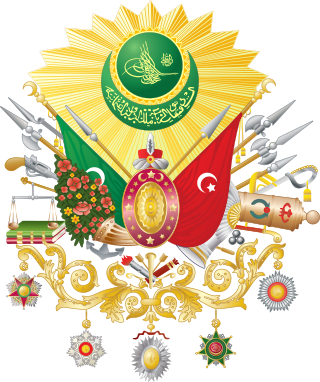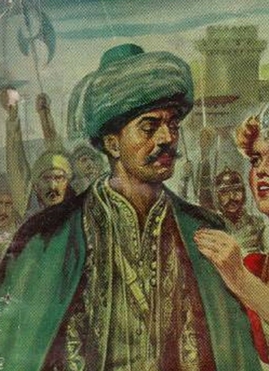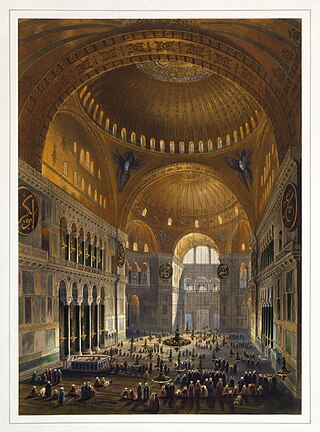
Bursa is a city in northwestern Turkey and the administrative center of Bursa Province. The fourth-most populous city in Turkey and second-most populous in the Marmara Region, Bursa is one of the industrial centers of the country. Most of Turkey's automotive production takes place in Bursa. As of 2019, the Metropolitan Province was home to 3,056,120 inhabitants, 2,161,990 of whom lived in the 3 city urban districts plus Gürsu and Kestel.

Edirne, historically known as Adrianople, is a city in Turkey, in the northwestern part of the province of Edirne in Eastern Thrace. Situated 7 km (4.3 mi) from the Greek and 20 km (12 mi) from the Bulgarian borders, Edirne was the second capital city of the Ottoman Empire from 1360s to 1453, before Constantinople became its capital.

Anadoluhisarı, known historically as Güzelce Hisar is a medieval Ottoman fortress located in Istanbul, Turkey on the Anatolian (Asian) side of the Bosporus. The complex is the oldest surviving Turkish architectural structure built in Istanbul, and further gives its name to the neighborhood around it in the city's Beykoz district.

Üsküdar is a municipality and district of Istanbul Province, Turkey. Its area is 35 km2, and its population is 524,452 (2022). It is a large and densely populated district on the Anatolian (Asian) shore of the Bosphorus. It is bordered to the north by Beykoz, to the east by Ümraniye, to the southeast by Ataşehir and to the south by Kadıköy; with Karaköy, Kabataş, Beşiktaş, and the historic Sarayburnu quarter of Fatih facing it on the opposite shore to the west. Üsküdar has been a conservative cultural center of the Anatolian side of Istanbul since Ottoman times with its landmark as well as numerous tiny mosques and dergahs.

The military of the Ottoman Empire was the armed forces of the Ottoman Empire. It was founded in 1299 and dissolved in 1922.

Fatih is a municipality and district of Istanbul Province, Turkey. Its area is 15 km2, and its population is 368,227 (2022). It is home to almost all of the provincial authorities but not the courthouse. It encompasses the historical peninsula, coinciding with old Constantinople. In 2009, the district of Eminönü, which had been a separate municipality located at the tip of the peninsula, was once again remerged into Fatih because of its small population. Fatih is bordered by the Golden Horn to the north and the Sea of Marmara to the south, while the Western border is demarked by the Theodosian wall and the east by the Bosphorus Strait.

Beyoğlu is a municipality and district of Istanbul Province, Turkey. Its area is 9 km2, and its population is 225,920 (2022). It is on the European side of Istanbul, Turkey, separated from the old city by the Golden Horn. It was known as the region of Pera surrounding the ancient coastal town Galata which faced Constantinople across the Horn. Beyoğlu continued to be named Pera during the Middle Ages and, in western languages, into the early 20th century.

Istanbul is the largest city in Turkey, straddling the Bosporus Strait, the boundary between Europe and Asia. It is considered the country's economic, cultural and historic capital. The city has a population of over 15 million residents, comprising 19% of the population of Turkey, and is the most populous city in Europe and the world's sixteenth-largest city.
The city of Istanbul has been known by a number of different names. The most notable names besides the modern Turkish name are Byzantium, Constantinople, and Stamboul. Different names are associated with different phases of its history, with different languages, and with different portions of it.

Mehmed Kâmil Pasha, also spelled as Kamil Pasha, was an Ottoman statesman and liberal politician of Turkish Cypriot origin in the late-19th-century and early-20th-century. He was the Grand Vizier of the Empire during four different periods.

Neolithic artifacts, uncovered by archeologists at the beginning of the 21st century, indicate that Istanbul's historic peninsula was settled as far back as the 6th millennium BCE. That early settlement, important in the spread of the Neolithic Revolution from the Near East to Europe, lasted for almost a millennium before being inundated by rising water levels. The first human settlement on the Asian side, the Fikirtepe mound, is from the Copper Age period, with artifacts dating from 5500 to 3500 BCE. In the European side, near the point of the peninsula (Sarayburnu) there was a settlement during the early 1st millennium BCE. Modern authors have linked it to the possible Thracian toponym Lygos, mentioned by Pliny the Elder as an earlier name for the site of Byzantium.

The architecture of Istanbul describes a large mixture of structures which reflect the many influences that have made an indelible mark in all districts of the city. The ancient part of the city is still partially surrounded by the Walls of Constantinople, erected in the 5th century by Emperor Theodosius II to protect the city from invasion. The architecture inside the city proper contains buildings and structures which came from Byzantine, Genoese, Ottoman, and modern Turkish sources. The city has many architecturally significant entities. Throughout its long history, Istanbul has acquired a reputation for being a cultural and ethnic melting pot. As a result, there are many historical mosques, churches, synagogues, palaces, castles and towers to visit in the city.

Gazi Hüseyin Pasha, also known as Deli Hüseyin Pasha or Sarı Hüseyin Pasha or Baltaoğlu Hüseyin Pasha, was an Ottoman military officer and statesman. He was governor of Egypt (1635–1637), Kapudan Pasha in the 1630s, and briefly Grand Vizier in 1656.

The Government of the Grand National Assembly, self-identified as the State of Turkey or Turkey, commonly known as the Ankara Government, or archaically the Angora Government, was the provisional and revolutionary Turkish government based in Ankara during the Turkish War of Independence (1919–1923) and during the final years of the Ottoman Empire. It was led by the Turkish National Movement, as opposed to the crumbling Constantinople Government/Istanbul Government, which was led by the Ottoman Sultan.

The Fossati brothers, Gaspare and Giuseppe (1822–1891), were Swiss architects. They completed more than 50 projects in Turkey during the Tanzimat era. They belonged to the Morcote branch of the Fossati, a prominent Ticinese family with mentions in the historical record going back to the 14th century. Gaspare is most noted for his renovation of the Hagia Sophia in Constantinople, which virtually saved it from destruction.

İzmit is a municipality and the capital district of Kocaeli Province, Turkey. Its area is 480 km2, and its population is 376,056 (2022). The capital of Kocaeli Province, it is located at the Gulf of İzmit in the Sea of Marmara, about 100 km (62 mi) east of Istanbul, on the northwestern part of Anatolia. Kocaeli Province had a population of 2,079,072 inhabitants in 2022, of whom approximately 1.2 million lived in the largely urban İzmit City metro area made up of Kartepe, Başiskele, Körfez, Gölcük, Derince and Sapanca. Unlike other provinces in Turkey, apart from Istanbul, the whole province is included within the municipality of the metropolitan center.

Ahmed Fethi Pasha, was an Ottoman marshal, ambassador and industrialist, who belonged to the Cretan Muslim community.

The 1864 Vilayet Law, also known as the Provincial Reform Law, was introduced during the Tanzimat era of the late Ottoman Empire. This era of administration was marked by reform movements, with provincial movements led largely by Midhat Pasha, a key player in the Vilayet Law itself. The Vilayet Law reorganized the provinces within the empire, replacing the medieval eyalet system.
Abaza Hasan Pasha, also called Kara Hasan Pasha or Celali Hasan Pasha;, was an Ottoman provincial governor and celali rebel of the mid-seventeenth century. He launched two rebellions against the Ottoman government, the second and largest of which ended with his assassination in Aleppo on 16 February 1659 following a failed attempt to force the deposition of the Grand Vizier Köprülü Mehmed Pasha.
There were multiple newspapers published in the Ottoman Empire.






























